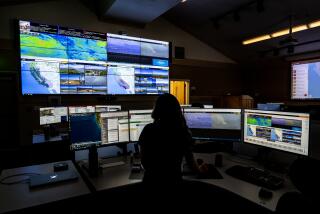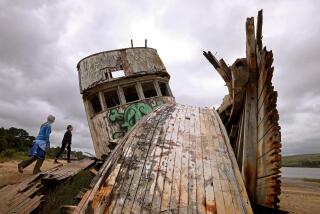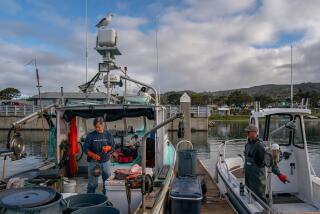Fund Cuts for Buoys Roil Waters : Infrastructure: Financing from the federal government dwindles, dismaying weather forecasters, fishermen and boaters.
Weather forecasters, fishermen and boaters alike are decrying the federal government’s recent budget-cutting plan to remove offshore weather buoys that they say are vital to their livelihoods.
The buoys provide a constant flow of information on offshore weather and wave conditions.
The high-tech devices will no longer be maintained due to the cost and will be removed from the ocean after their signals die.
At least three of the nine West Coast buoys targeted for removal are used by Ventura County-based boaters. National Weather Service meteorologists are upset as well.
“The buoys are really quite valuable,” said John Henderson, marine program leader at the weather service. “It’s hard to imagine forecasting without them.”
And Ventura County commercial fishermen like Pete Dupuy said the loss of the buoys will cost them money. Dupuy said the three buoys--two in the Santa Barbara Channel and a third about 20 miles off the coast of Santa Monica--provide invaluable weather information daily.
The buoys’ weather data is broadcast on the radio daily. Dupuy relies heavily on the information when deciding whether to leave port. He predicted he will burn 20% more fuel a year once the buoys are pulled because he won’t know the conditions offshore until he gets there.
If conditions prove unsafe at his favorite fishing haunts, Dupuy will return to port.
“It’s ridiculous. Everybody is upset,” said Dupuy, head of the Pacific Offshore Fishermen’s Assn.
Forecasters, too, depend on the buoys.
Air and water temperatures along with wave data recorded by the 10-foot-diameter disks provide offshore information that would be otherwise unavailable to forecasters, Henderson said.
The recorded data is beamed to a satellite overhead. From there, forecasters collect the buoys’ data and use it to predict offshore weather and wave conditions. Their forecast is broadcast on KWO-37, the 24-hour shortwave weather station.
“The wave data is most interesting to us,” Henderson said. The buoys record the height, speed and direction of the waves, important information for boaters, he said.
“We are not completely blind without the buoys,” Henderson said. “But we are blind in a lot of spots.”
He said forecasters will now have to rely on land-placed sensors and lifeguard observations to guess at offshore conditions.
“It will be tainted observations,” he said.
Federal officials said seven agencies pay for the 28 weather buoys placed around the country.
“When those agencies pull their funds, we have no choice but to pull those buoys,” said Coast Guard Capt. Gary Bird, who is in charge of maintaining the buoys.
He said each buoy costs between $50,000 and $100,00 a year to operate. The three local buoys being pulled are funded by the Bureau of Land Management and the Army Corps of Engineers, Bird said.
The buoys were placed in Southern California in the early 1980s, Henderson said. They will remain in place until they malfunction.
“That could be tomorrow or in six months,” he said.
More to Read
Sign up for Essential California
The most important California stories and recommendations in your inbox every morning.
You may occasionally receive promotional content from the Los Angeles Times.









